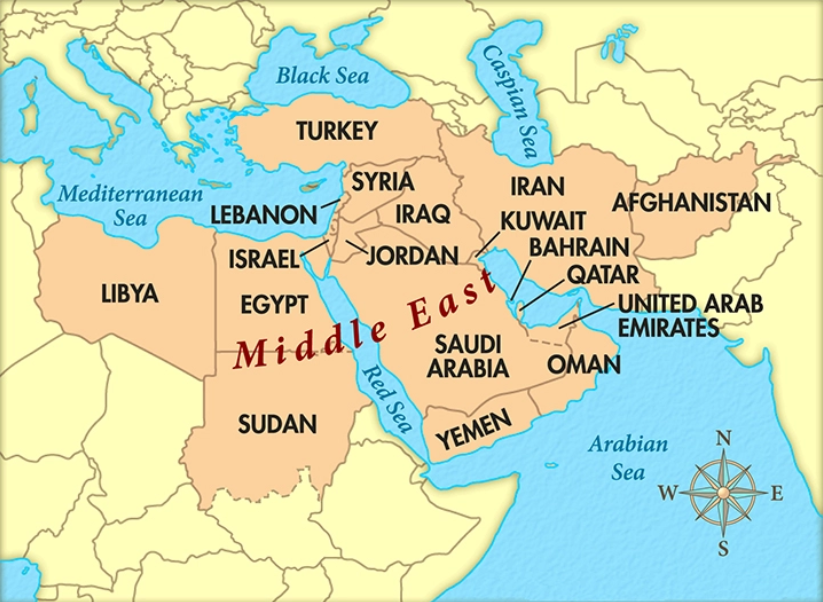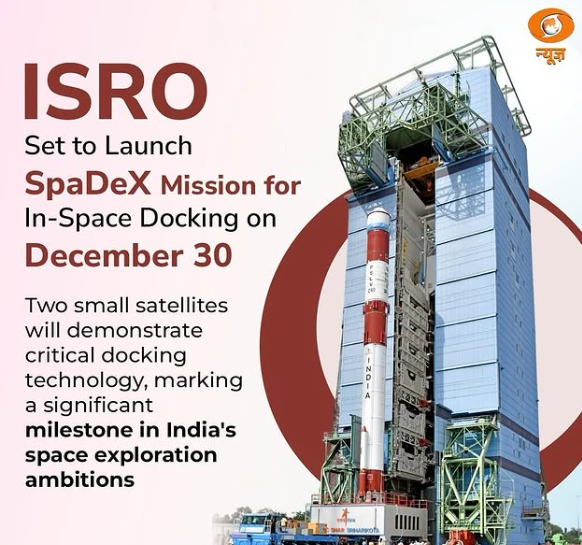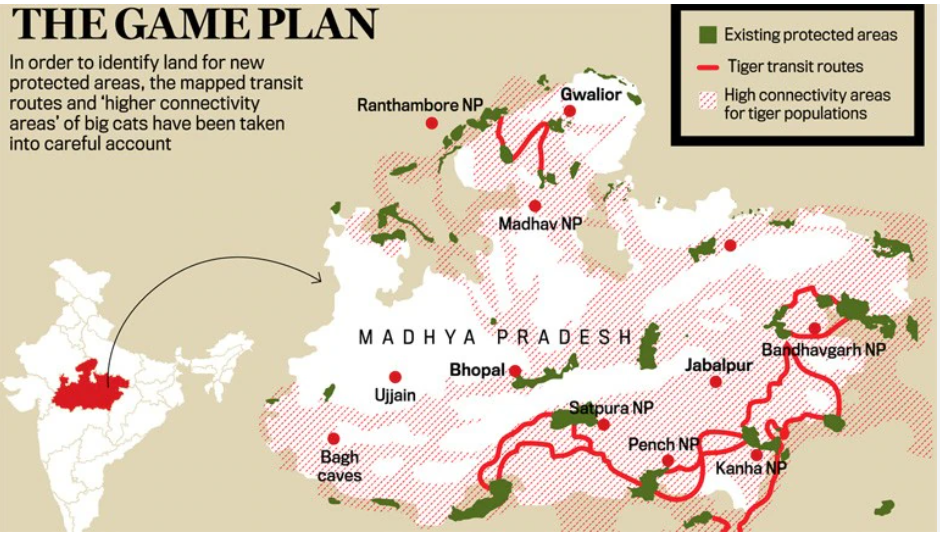30 December 2024 : Daily Current Affairs
1. ‘U.S.-India ties will be strengthened, but expect tariff hikes’
- 1. ‘U.S.-India ties will be strengthened, but expect tariff hikes’
- 2. The challenge of holding judges accountable
- 3. Accelerated movement: logistics sector high on delivery, low on cost
- 4. 2024: The Year AI Redefined Technology and Challenges Shaped its Future
- 5. Israel’s Escalating Strikes on Yemen: A New Front in the Middle East Proxy War
- 6. India-Australia Economic Cooperation and Trade Agreement marks two years of success
- Prelims Facts
- 1. India shuts down Internet 60 times in 2024, the lowest in eight years
- 2. ISRO to sign off 2024 with space docking experiment mission today
- 3. Study Reveals Human Brain Processes Thought 5 Times Slower Than Wi-Fi
- 4. Tiger Translocation from Madhya Pradesh
- 5. Parker Solar Probe: First Human-Made Object to Fly Close to the Sun
- About Parker Solar Probe (2018)
- Significance of the Flyby
(Source – The Hindu, International Edition – Page No. – 5)
| Context |
|
Strengthening Strategic Ties
- The first Trump administration saw a significant boost in U.S.-India relations, especially in strategic areas.
- U.S. identified China as a strategic challenge, aligning India’s interests with the U.S. in the Indo-Pacific region.
- The Quad (U.S., India, Japan, Australia) was revived and continues under the Biden administration, laying a strong foundation for future cooperation.
- Further strengthening of defense ties is expected, including more military exercises and foundational agreements.
- The focus will likely remain on countering China’s growing influence in the region.
Trade Relations: Tariffs and Market Access
- President Trump pushed for India to lower tariffs and open up markets, a stance likely to continue in the second term.
- India lost its GSP (Generalized System of Preferences) status under the previous administration, signaling tensions in trade relations.
- The Trump administration may impose tariffs of 10-20% on most countries, including India, to address perceived protectionism.
- Such tariffs could serve as a negotiation tactic to secure better trade terms, particularly in goods and services.
- The trade discussions will likely focus on finding a balance that benefits both nations.
Energy and Economic Policies
- The previous administration’s “maximum pressure” campaign on Iran led India to halt oil imports from Iran, and similar policies are expected in the second term.
- The U.S. may push India to comply with sanctions on other nations, continuing its aggressive foreign policy stance.
- Energy cooperation between the two countries will likely remain a key issue, with discussions about alternatives to Iranian oil and the broader energy market.
- In addition to energy, broader economic cooperation may include technology, services, and other sectors critical to both economies.
Impact of Domestic Legal Issues
- Legal cases involving Indian businesses, such as investigations into entities like Adani, are unlikely to influence the broader diplomatic relationship.
- The Trump administration is expected to refrain from intervening directly in such cases, ensuring these issues do not derail U.S.-India ties.
- While these investigations may be significant domestically, they are not expected to affect foreign policy.
Diplomatic Strategy
- The appointment of the next U.S. ambassador to India will be crucial for managing relations.
- The ambassador must be well-versed in Trump’s diplomatic style to effectively translate Washington’s policies to the Indian government.
- Handling any statements or controversies from the U.S. will be a key role for the new envoy.
Conclusion
- Overall, U.S.-India relations under the second Trump administration are expected to strengthen in defense cooperation, trade negotiations, and energy policies.
- Strategic alignment against China will continue to be a cornerstone, while trade issues will likely require delicate negotiation to ensure mutual benefits.
| PYQ: ‘Indian diaspora has a decisive role to play in the politics and economy of America and European Countries’. Comment with examples. (150 words/10m) (UPSC CSE (M) GS-2 2020) |
| Practice Question: Analyze the potential changes in U.S.-India relations during Donald Trump’s second term, with emphasis on strategic and economic aspects. (150 Words /10 marks) |
2. The challenge of holding judges accountable
(Source – The Hindu, International Edition – Page No. – 10)
| Context |
|
Introduction to Judicial Accountability
- Judicial accountability refers to the obligation of judges to be answerable for their actions, ensuring integrity, transparency, and trust in the judiciary.
- In India, judicial accountability is governed by the Judges (Inquiry) Act, 1968, and is subject to provisions under Articles 124, 217, and 218 of the Constitution.
The Review Mechanism in India
- The review mechanism involves a three-member committee, comprising a Supreme Court judge, a Chief Justice of a High Court, and an eminent jurist.
- The committee investigates allegations of “misbehavior or incapacity” of judges. However, the process only begins after an impeachment motion is introduced in Parliament.
- The motion requires a two-thirds majority in the Lok Sabha or an absolute majority in the Rajya Sabha for removal from office.
| Case Studies of Impeachment Proceedings |
|
Challenges in Holding Judges Accountable
- Judges in India enjoy significant immunity and can escape accountability by resigning before formal proceedings.
- This immunity is greater than that afforded to elected officials, highlighting a gap in the system’s ability to hold judges to account for misconduct.
- Resigning before an impeachment process essentially nullifies the possibility of accountability, undermining public trust in the judiciary.
The Role of Judicial Accountability Campaigns
- The Forum for Judicial Accountability (FJA) has advocated for continued investigations into judicial misconduct, even after a judge’s resignation, to ensure that accountability mechanisms are not circumvented.
- The FJA emphasizes that impeachment is not just about removal but restoring the integrity of the judicial system.
Conclusion
- Judicial accountability in India remains a challenge due to the existing immunity granted to judges and the limitations of the current review process.
- Strengthening the judicial review mechanism and ensuring that judges cannot evade scrutiny through resignation is crucial for maintaining public trust in the judicial system.
- Reforming these processes will help restore confidence in the judiciary and uphold the values of justice and transparency in India.
| Practice Question: Analyze the effectiveness of the judicial accountability mechanisms in India. What improvements are needed to ensure greater transparency and responsibility in the higher judiciary? (250 Words /15 marks) |
3. Accelerated movement: logistics sector high on delivery, low on cost
(Source – The Hindu, International Edition – Page No. – 13)
| Context |
|
National Logistics Policy (NLP):
- The Indian government launched the National Logistics Policy (NLP) in 2022 to improve the logistics sector’s efficiency and reduce costs.
- India’s logistics performance improved significantly, rising to 38th place out of 139 nations in the World Bank Logistics Performance Index in 2023.
- The policy aims to reduce logistics costs, which currently stand between 10-14% of the country’s GDP.
Key Government Initiatives
- PM Gati Shakti National Master Plan:
- Launched in 2021, this initiative aims to boost infrastructure and ensure faster, more efficient logistics across the country.
- It focuses on improving coordination between various ministries for better infrastructure planning and execution.
- Unified Logistics Interface Platform (ULIP):
- ULIP was introduced as a digital platform to streamline logistics operations by enabling real-time data exchange.
- As of 2023, over 600 entities have registered on ULIP, and 57 applications have gone live for logistics operations like cross-border trade and last-mile delivery optimization.
- Electrification and Port Policy:
- Short railway lines connecting container depots and freight stations have been electrified to speed up goods movement.
- A new Marine Policy under the NLP was launched to improve port-related logistics.
Impact of Goods and Services Tax (GST)
- GST’s Role in Reducing Logistics Costs:
- The implementation of GST has helped reduce logistics costs by minimizing waiting times at state borders.
- Trucks now travel an average distance of 300-325 km, up from 225 km, thanks to reduced delays, lowering transportation costs.
- Logistics Cost Reduction:
- Between FY14 and FY22, logistics costs in India declined by 0.8-0.9 percentage points of GDP, according to a report by the National Council of Applied Economic Research (NCAER).
Digitalization and Infrastructure Development
- Digitalization of the Logistics Sector:
- Over 600 entities registered on ULIP, with 57 live applications enhancing the digital infrastructure of the logistics sector.
- These applications help in various logistics functions, including process automation, document digitization, and data exchange.
- Infrastructure Investments:
- Increased capital expenditure in 2024 supports growth in the sector, including improvements in rail, road, and waterways.
- Multi-modal connectivity is being emphasized, with an expansion in the use of rail and waterway freight alongside highway construction.
Future Outlook and Growth
- Sector Expansion:
- The logistics sector grew at a rate of 12% in 2024, driven by e-commerce, increased domestic consumption, and government-backed initiatives like Gati Shakti and NLP.
- The sector, valued at $250 billion, contributes 14% to India’s GDP and is expected to continue its growth trajectory.
- Focus on Skilling: There is a need for better workforce training to handle the growing demands of the logistics sector and to ensure efficient operations.
Conclusion
- The logistics sector in India is evolving rapidly due to government reforms, digitalization, and infrastructure improvements.
- With continued investments and policy support, the sector is well-positioned for significant growth in the coming years.
| Practice Question: Analyze the role of the National Logistics Policy in enhancing India’s logistics sector and reducing costs. (150 Words /10 marks) |
4. 2024: The Year AI Redefined Technology and Challenges Shaped its Future
(Source – Indian Express, Section – Explained, Page No. – 14)
| Topic: GS3 – Science & Technology |
| Context |
|
Analysis of the news:

What is AI?
- AI is the ability of a computer, or a robot controlled by a computer to do tasks that are usually done by humans because they require human intelligence and discernment.
- Although there is no AI that can perform the wide variety of tasks an ordinary human can do, some AI can match humans in specific tasks.
The Role of AI in 2024: Promise and Challenges
- AI emerged as the defining technology of the decade in 2024, with widespread adoption across industries.
- While responsible AI and greener tech made significant strides, challenges persisted in realizing tangible returns on investment.
- Many early adopters recalibrated their deployment strategies, focusing on impactful use cases.
- AI increasingly complemented human expertise as a copilot, shifting the workforce’s focus to innovation and elevated thinking.
Evolution of AI Agents
- AI agents gained traction for automating routine tasks without direct human input, creating efficiencies across domains.
- By December 2024, over 3 million custom GPTs were developed, signaling a shift beyond chat-based AI to pre-programmed agents.
- Ethical concerns arose, such as their role in decision-making and interactions, highlighting the need for accountability.
Transformation of Data Analytics
- The rise of generative AI is rendering traditional dashboards obsolete. Conversational AI tools now deliver tailored insights, visualizations, and predictions directly in response to queries.
- This evolution demands a more sophisticated approach to data collection and structuring, ensuring compatibility with advanced analytical models.
Crisis in Social Media
- Major platforms like TikTok and X faced existential challenges, while Instagram maintained growth despite questionable practices.
- Younger users shifted to private, closed-group platforms, reflecting a decline in the appeal of traditional bulletin board-style social media.
- The sector awaits a disruptive innovation to re-engage audiences.
Advancements in Computing Power
- Quantum computing breakthroughs, such as Google Willow chips and NVIDIA’s cutting-edge GPUs, are pushing the limits of AI’s capabilities.
- However, as computational power grows, concerns arise about the adequacy of existing data models.
- This could prompt a rethinking of AI development trajectories.
AI and Hardware Integration
- Attempts to embed AI into hardware faced setbacks in 2024, with early products failing to meet expectations.
- The next wave of AI-driven devices is expected to focus on specific, practical use cases, paving the way for innovations like AI-centric smartphones and laptops.
- The future promises bold experimentation in AI-hardware synergy.
Conclusion:
- The advancements in AI throughout 2024 have cemented its role as a transformative force, driving innovation while posing critical challenges in adoption, ethics, and sustainability.
- As we move forward, the focus must shift to refining AI’s applications, ensuring responsible use, and fostering a balance between technological progress and societal needs.
- The lessons of 2024 will guide the recalibration required for AI to truly unlock its potential in shaping a better future.
| Ethical considerations & Potential risks |
|
| PYQ: With the present state of development, Artificial Intelligence can effectively do which of the following? (2020) Bring down electricity consumption in industrial unitsCreate meaningful short stories and songsDisease diagnosisText-to-Speech ConversionWireless transmission of electrical energy Select the correct answer using the code given below: (a) 1, 2, 3 and 5 only (b) 1, 3 and 4 only (c) 2, 4 and 5 only (d) 1, 2, 3, 4 and 5 Ans: (b) |
| Practice Question: Examine the transformative role of Artificial Intelligence (AI) in 2024 for industries and society. How can responsible AI practices ensure equitable and sustainable progress? (250 Words /15 marks) |
5. Israel’s Escalating Strikes on Yemen: A New Front in the Middle East Proxy War
(Source – Indian Express, Section – Explained, Page No. – 14)
| Context |
|
Analysis of the news:

Expansion of Israeli Operations
- Israel’s airstrikes in Yemen, including the bombing of Sana’a airport during a UN delegation’s presence, signal a significant escalation in its campaign against Iran and its regional allies.
- These operations target the Houthi group, which Israel considers a critical Iranian proxy, amid debates about focusing on Yemen or Iran itself.
Impact on Regional Dynamics
- The strikes reflect broader geopolitical tensions. The Houthis, buoyed by Iranian military aid and Russian intelligence, have heightened their attacks, targeting Israel and disrupting maritime trade.
- This disruption has global implications, evidenced by reduced Suez Canal traffic and economic strain on Israel’s Red Sea port.
Houthis’ Position in the Yemeni Civil War
- Despite facing opposition from other factions, such as the UAE-backed Southern Transitional Council, the Houthis have solidified control in northern Yemen.
- Their recruitment drive and ability to withstand international air campaigns highlight their growing influence domestically and regionally.
Role in the ‘Axis of Resistance’
- The Houthis have emerged as a central force within Iran’s “axis of resistance,” leveraging their position amid the weakening of Hezbollah and Hamas.
- Coordinated efforts with Iraqi Shia militias further enhance their operational reach, positioning them as key actors in ongoing regional conflicts.
Conclusion
- The escalation of Israeli strikes in Yemen underscores the intensifying proxy battles in the Middle East.
- With significant implications for regional stability and global trade, the conflict highlights the interplay of local ambitions and international geopolitics in shaping outcomes.
| Why does the Middle East Consistently Remain a Region of Persistent Conflict and Instability? |
|
| PYQ: ‘India’s relations with Israel have, of late, acquired a depth and diversity, which cannot be rolled back.” Discuss. (150 words/10m) (UPSC CSE (M) GS-2 2018) |
| Practice Question: Analyze the implications of Israel’s recent airstrikes in Yemen on the Houthi group, considering the broader geopolitical dynamics in the Middle East and the evolving role of the Houthis within the ‘axis of resistance.’ (250 Words /15 marks) |
6. India-Australia Economic Cooperation and Trade Agreement marks two years of success
(Source – https://pib.gov.in/PressReleseDetail.aspx?PRID=2088669®=3&lang=1 )
| Context |
|
India-Australia Economic Partnership Overview
Ind-Aus ECTA Success:
- The India-Australia Economic Cooperation and Trade Agreement (Ind-Aus ECTA) has been successful in boosting bilateral trade, growing from USD 12.2 billion in 2020-21 to USD 26 billion in 2022-23.
- The total trade for 2023-24 moderated to USD 24 billion, with India’s exports to Australia growing by 14%.
Trade Momentum:
- From April-November 2024, total merchandise bilateral trade reached USD 16.3 billion, continuing the positive trade momentum.
- The implementation of the agreement is evident, with export utilization at 79% and import utilization at 84%.
Sectoral Growth:
- Key sectors such as textiles, chemicals, and agriculture have witnessed substantial growth.
- The agreement has also facilitated the export of new products like gold studded with diamonds and turbojets, showcasing diversification.
- Imports of essential raw materials such as metalliferous ores, cotton, and wood have supported India’s industries.
Future Prospects:
- Both India and Australia are now working on the Comprehensive Economic Cooperation Agreement (CECA), which aims to build on the ECTA’s foundation.
- Ten formal rounds and inter-sessional discussions have already been held.
Target for 2030:
- Both countries aim to achieve a trade target of AUD 100 billion by 2030, strengthening the economic relationship and driving mutual prosperity.
Conclusion:
- The successful completion of ECTA and the ongoing work on CECA will continue to deepen the economic ties between India and Australia, contributing to a more resilient global economy.
| Practice Question: Evaluate the progress of the India-Australia Economic Cooperation and Trade Agreement (Ind-Aus ECTA) and its impact on bilateral trade. How can this partnership be strengthened further? (250 Words /15 marks) |
Prelims Facts
1. India shuts down Internet 60 times in 2024, the lowest in eight years
(Source – The Hindu, International Edition – Page No. – 4)
| Context |
|
Analysis of the news:
- India saw the lowest number of mobile Internet shutdowns in eight years in 2024, with 60 shutdowns, compared to 96 in 2023.
- Shutdowns were fewer in Manipur and Jammu and Kashmir, regions with historically high numbers of curbs.
- Recent shutdowns occurred in Ambala, Haryana, due to farmer agitations, and in Manipur due to law and order issues.
- The highest number of shutdowns, 132, occurred in 2020 after the revocation of Article 370.
- Digital rights activists argue that shutdowns are ineffective and unnecessary, and often not published as required by the Supreme Court.
- The government has not conducted any study on the impact or efficacy of Internet shutdowns, and no centralised data is maintained.
2. ISRO to sign off 2024 with space docking experiment mission today
(Source – The Hindu, International Edition – Page No. – 6)
| Context |
|
SpaDeX Mission Overview

- The mission is being launched by the Indian Space Research Organisation (ISRO) using the Polar Satellite Launch Vehicle (PSLV) C60.
- The launch is scheduled for 9:58 p.m. from the Satish Dhawan Space Centre, Sriharikota.
- The main aim is to test the Space Docking Experiment (SpaDeX), which will demonstrate the ability of spacecraft to dock in space.
Space Docking Experiment (SpaDeX)
- SpaDeX will show how two small spacecraft can rendezvous, dock, and undock in space.
- This technology is crucial for future space missions, such as satellite servicing, space station operations, and even missions to the moon or other planets.
- It will also help in building and operating an Indian space station in the future.
Spacecraft and Launch Details
- Two small spacecraft, Chaser (SDX01) and Target (SDX02), will be launched into space.
- Both spacecraft will be placed in a 470 km orbit and separated by 15 minutes after launch.
- After separation, they will slowly drift apart by 10-20 km and then align to meet for docking.
Significance and Future Prospects
- This mission is an important step for India to develop docking capabilities in space.
- It will help make future space missions more advanced, including sending astronauts to the moon.
3. Study Reveals Human Brain Processes Thought 5 Times Slower Than Wi-Fi
(Source – Indian Express, Section – Explained, Page No. – 14)
| Context |
|
Analysis of the news:
Comparison of Processing Speeds
- The study highlights a stark difference between the speed of information processing in the human brain and technological systems.
- While the human brain processes thought at a rate of just 10 bits per second (bps), a typical Wi-Fi connection operates at 50 bps.
- This contrast underscores the limitations of human cognition when compared to modern computational systems.
Study Overview
- Published in Neuron under the title “The unbearable slowness of being: Why do we live at 10 bits/s?”, the study analyzed human behaviors such as reading and writing.
- It concluded that conscious thought is significantly slower than sensory processing or computational systems.
- Neuroscientists emphasized this gap, countering the narrative of the brain’s unparalleled complexity with empirical data on its processing speed.
Evolutionary Perspective
- The slow pace of conscious thought may be an evolutionary adaptation.
- According to the study, human ancestors evolved in ecological niches where environmental changes were gradual, requiring only 10 bps in extreme situations.
- Most of the time, the brain’s processing speed was sufficient for survival in a relatively slow-moving world.
Sensory Processing vs. Conscious Thought
- While conscious thought is limited to 10 bps, sensory systems like sight, smell, and sound process information about 100 million times faster.
- This disparity highlights the brain’s efficiency in handling immediate sensory inputs while prioritizing deliberate, slower cognitive functions for conscious thought.
4. Tiger Translocation from Madhya Pradesh
| Context |
|
Analysis of the news:

Tiger Translocation from Madhya Pradesh Overview:
The Madhya Pradesh government has announced the translocation of 15 tigers to the states of Rajasthan, Chhattisgarh, and Odisha.
- This initiative involves 12 tigresses and 3 tigers, subject to approval from the Central Government.
- The tigers will be relocated from the Bandhavgarh, Pench, and Kanha Tiger Reserves.
About Inter-state Tiger Translocation Projects
Objective:
- Re-introduction of a tiger population in an area once part of its historical range, but from which it has been extirpated or become extinct.
- Reinforcement/Supplementation of tigers to an existing population to enhance its long-term viability.
- The first tiger relocation project was initiated in 2018 wherein two big cats, from Kanha Tiger Reserve and Bandhavgarh, were relocated to Satkosia Tiger Reserve (Odisha).
- National Tiger Conservation Authority (NTCA) plays key role in facilitating such projects.
About Kanha Tiger Reserve (KTR)
Kanha Tiger Reserve, also known as Kanha National Park, is the largest national park in Madhya Pradesh.
- Location: Spread across Mandla and Balaghat districts, nestled in the Maikal range of Satpuras, forming part of the Central Indian Highlands.
- History: It was established as a national park on June 1, 1955, and Declared a Tiger Reserve in 1973.
- Cultural Reference: The reserve inspired Rudyard Kipling’s “The Jungle Book”.
- Mascot: First in India to introduce an official mascot, Bhoorsingh the Barasingha.
- Flora: Lowland Forests are dominated by sal (Shorea robusta) and mixed forest trees interspersed with meadows. Highland Forests consist of tropical moist deciduous trees with bamboo (Dendrocalamus strictus) on slopes.
- Fauna: Significant populations of Royal Bengal Tigers, leopards, sloth bears, and Indian wild dogs. Globally renowned for saving the Barasingha (state animal of Madhya Pradesh) from extinction.
About Bandhavgarh Tiger Reserve
Located in the Umaria district of Madhya Pradesh, Bandhavgarh Tiger Reserve lies between the Vindhyan and Satpura ranges.
- History: It was declared a national park in 1968 and became a Tiger Reserve in 1993.
- Cultural Significance: Home to the Bandhavgarh Fort, said to have been gifted by Lord Rama to his brother Lakshmana, lending the name Bandhavgarh (“Brother’s Fort”).
- Vegetation: Dominated by tropical moist deciduous forests, sal trees, grasslands, and bamboo on lower slopes. Notable species include Saj, Dhaora, Tendu, Arjun, Amla, and Palas.
- Fauna: Known for the highest density of Royal Bengal Tigers in India and the world. Other species like Leopards, wild dogs, wolves, jackals, chital, sambar, barking deer, nilgai, and chowsingha.
About Pench Tiger Reserve
Pench Tiger Reserve spans the Seoni and Chhindwara districts in Madhya Pradesh and extends into the Nagpur district in Maharashtra.
- Named after: The Pench River, flowing north to south through the reserve.
- Components: Includes the Indira Priyadarshini Pench National Park, Pench Mowgli Sanctuary, and a buffer zone.
- Cultural connection: Inspired by Rudyard Kipling’s “The Jungle Book”.
- Terrain: Undulating landscape with small hills and steep slopes.
- Vegetation: Mosaic of vegetation types, from moist valleys to dry deciduous forests.
- Flora: Diverse flora includes teak, saag, mahua, and various grasses and shrubs.
- Fauna: Abundant populations of Chital, Sambar, Nilgai, Gaur (Indian Bison), and wild boar.
- Key predators: Tiger, followed by leopard, wild dogs, and wolf.
- Rich avian diversity with over 325 species of birds, including the Malabar Pied Hornbill, Indian Pitta, and Grey-Headed Fishing Eagle.
5. Parker Solar Probe: First Human-Made Object to Fly Close to the Sun
| Context |
|
Analysis of the news:
About Parker Solar Probe (2018)

Objective: Launched to fly into the outermost part of the Sun’s atmosphere, the corona, to improve the understanding of solar wind. Solar wind is a continual stream of protons and electrons from the corona.
Key Scientisfic Instruments: Fields Experiment (FIELDS), Integrated Science Investigation of the Sun (IS☉IS ), etc.
Significance of the Flyby
- Study Solar Heating:
- Investigate how solar material in the corona heats up to millions of degrees.
- Understand Solar Wind:
- Trace the origin of the solar wind, the continuous flow of charged particles emitted by the Sun.
- Explore Energetic Particles:
- Examine how particles accelerate to near-light speeds in the Sun’s atmosphere.
- Valuable Insights:
- Data from the mission will help scientists understand the origins and behavior of solar phenomena, contributing to space weather prediction and solar physics.
- Provide insights into solar energy processes, impacting our understanding of the Sun-Earth relationship.
For more such UPSC-related Current Affairs, Check Out- 28 December 2024: Daily Current Affairs


